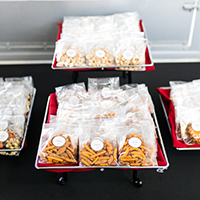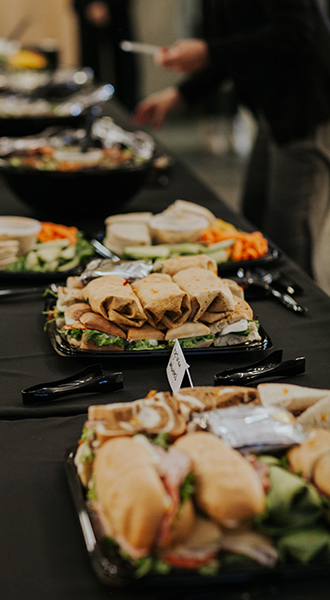Menu Planning – What to Consider and Why
Planning a menu is often an after–thought for many, but it is an important aspect of an event that truly requires thoughtful consideration.
Few things are worse as an event attendee than walking through the buffet line after a long morning session, ready for lunch and realizing there is nothing that you can/should/want to eat, or even worse that there isn’t enough food. Below are four important tips to consider when picking the menu for your next event:

Who’s your audience?
Are you serving 100 football players or figure skaters? While it’s not a hard and fast rule, you can generally land on a menu direction by thoughtfully considering who it is you’ll be serving. This will also help you determine portion size. For example, for the football players you may want to consider a heartier option like pasta or beef. For the figure skaters something lighter like a grilled chicken option is a great choice. Furthermore, what is the average age of the group? Hamburgers, hot dogs, and mac & cheese might fly for a younger audience, but you’ll want to be sure to include some healthy options, such as a salad, for a more mature group.
What’s the purpose of the event?
The reason you’re holding the event is also something to consider when planning a menu. There are many different options for serving your meals such as a buffet, plated dinner, or passed hors d’oeuvres. In a situation where you’re hoping your guests will mingle and network, passed hors d’oeuvres are a great option. However, at an event where you would like for your guests to have more in–depth conversations and a more structured approach than the passed appetizers, buffets are a good alternative. They keep things moving along and your attendees can sit with whomever they please. Also keep in mind that you can assign seats during a plated meal for a more strategic approach. In any case, be sure to be mindful of the type of environment you’re hoping to generate and build from there.
Are there are any dietary restrictions?
If you have the opportunity, it is always a good idea to ask guests of any dietary restrictions ahead of time. Often if there are only a few people that have specific restrictions, the chef/venue will be happy to create a separate plate for these individuals. However, if finding out early is not possible, a good rule of thumb is to at the very least plan and prepare for vegetarian options. To accomplish this, just be sure that not every item ordered has meat (i.e. no bacon on the salad, spaghetti and marinara versus meat sauce) and try to consider if there would be enough to fill up someone who is a vegetarian, even if most of the main–course options are meat–based. Pasta, rice, and beans are a great way to accomplish this. Additionally, be sure to label all your dishes clearly to protect those with allergies. This also helps to keep the line moving and avoid having your guests standing there trying to guess what they are putting on their plates.
Are there enough options that everyone will feel satisfied?
There’s a fine line between having too much food and not enough, but it’s always better to err on the side of caution to ensure that every guest walks away full and happy. Certain ingredients, such as mushrooms or red onions, tend to be polarizing (you either love them, or hate them) and while you don’t need to avoid these altogether, try to stay away from choosing several dishes that feature a potentially unpopular item. For example, if one of your main entrées is Chicken Marsala, you may want to avoid selecting the Beef Stroganoff, too. To cover all bases, you’re usually safe with three entrée options: chicken, beef, and vegetarian, with a handful of sides to compliment them.
Ultimately, try not to stress about picking a great menu that your attendees will enjoy. Just remember to consider your audience, be thoughtful about the environment and purpose, remember restrictions, and provide several options. Picking a menu can be an exciting part of any event, so don’t forget to have fun!




